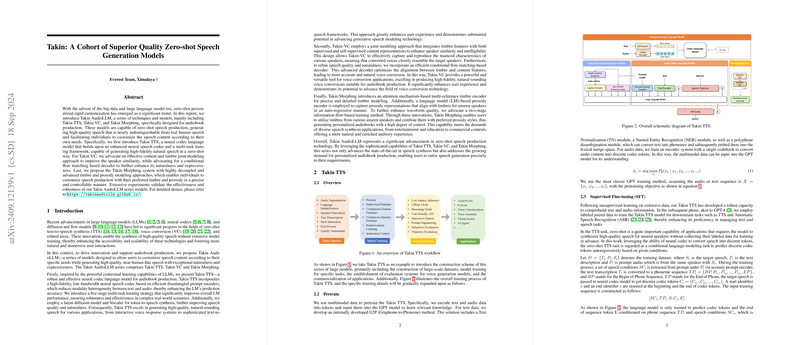Takin: A Cohort of Superior Quality Zero-shot Speech Generation Models
The paper "Takin: A Cohort of Superior Quality Zero-shot Speech Generation Models" introduces Takin AudioLLM, a novel series of techniques and models designed to enhance zero-shot speech generation, particularly focused on the audiobook production domain. The key components include Takin TTS (Text-to-Speech), Takin VC (Voice Conversion), and Takin Morphing. Each of these models is built to generate high-quality, natural-sounding speech with minimal data input and offers significant advances in personalized and controllable speech synthesis.
Overview
The Takin AudioLLM suite aims to address pressing challenges in speech synthesis, leveraging advancements in LLMs, neural codecs, and diffusion models. The series is primarily focused on maximizing speech quality, naturalness, and expressiveness in zero-shot scenarios, making these technologies more accessible and scalable.
Takin TTS
Takin TTS integrates a robust neural codec LLM enhanced by a multi-task training framework. It builds upon the natural learning capabilities of LLMs to produce high-fidelity speech. Key improvements include:
- Pretraining and Fine-tuning: The model is pretrained on large multilingual datasets and fine-tuned on domain-specific data to improve accuracy and expressiveness. The model boasts a multi-task training strategy incorporating text normalization and phoneme prediction to enhance the prediction accuracy.
- Conditional LLMing: Leveraging neural codec converters, Takin TTS predicts speech tokens from text input under zero-shot conditions. This approach ensures the synthesis of high-quality speech even for unseen text and speakers.
- Reinforcement Learning: A novel RL approach is used to further align the model outputs with human preferences, significantly improving its stability and fidelity in real-world applications.
- Instruction-based Fine-tuning: Introducing an instruction-based control mechanism allows for precise adjustments in speech synthesis, such as emotion and prosody, further extending the model's adaptability to varied scenarios.
Takin VC
Takin VC deploys a joint modeling approach integrating timbre features with both supervised and self-supervised content representations to enhance speaker similarity and intelligibility. The key innovations include:
- Content and Timbre Modeling: A hybrid PPG and timbre modeling system captures and reproduces the nuanced characteristics of various speakers.
- Conditional Flow Matching-Based Decoder: This advanced decoder improves the naturalness and alignment of voice conversion, leading to more accurate speaker simulations.
Takin Morphing
Takin Morphing facilitates customized speech production with advanced modeling of timbre and prosody, allowing for precise control over the synthesized output:
- Attention Mechanism for Timbre Encoding: Multi-reference timbre encoding ensures detailed timbre modeling for various unseen speakers.
- Prosody Encoder: An LM-based encoder captures prosody representations, enabling fine-grained control over the expressive aspects of speech synthesis.
Experimental Results
The experiments validate the robustness and effectiveness of the proposed models:
- Takin TTS: Shows significant improvements over baseline models with a final PER of 3.14% for English and 3.05% for Chinese, achieving near-human-level naturalness.
- Takin VC: Outperforms several state-of-the-art models (DiffVC, ValleVC, and NS2VC) in sound quality with a QMOS of 4.02 and a SIM of 0.80.
- Takin Morphing: Demonstrates superior zero-shot speech synthesis and prosody transfer capabilities, closely matching real human speech in both subjective and objective evaluations.
Implications and Future Directions
The Takin models hold substantial implications for the fields of speech synthesis and voice conversion. Their ability to produce high-quality speech with minimal data opens up new opportunities in personalized AI applications, from dynamic audiobooks to advanced virtual assistants and interactive educational tools. Moreover, the framework's adaptability to various domains suggests potential for broader applications in entertainment, healthcare, and training programs.
Future developments may focus on optimizing the models' efficiency to further reduce computational overhead during inference, thereby enhancing real-time performance and scalability. Additionally, integrating more complex emotional and contextual cues may further refine the naturalness and expressiveness of synthesized speech, pushing the boundaries of human-like AI interactions.
